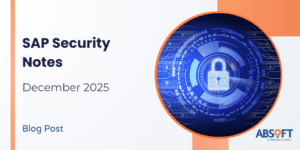We’ve all heard the AI hype. But lately, something’s shifted — and it’s not just the models getting better. It’s that AI is finally getting to work in everyday business processes, helping teams move faster, make smarter decisions, and, increasingly, operate with less friction. AI isn’t some far-future concept; it’s already here, and it’s evolving fast.
The latest wave of innovation, from OpenAI’s new agentic capabilities to real-world automation in finance, operations, and HR, shows us that the AI conversation is no longer about “what if?” It’s about “what now?” As AI begins to embed itself deeper into business operations, we’re starting to see where it delivers the most value, not in isolated pilots, but in day-to-day work. It’s being used to lighten the load, take care of routine decisions, and make complex tasks easier to manage. Â
For SAP customers, this means moving beyond isolated pilots toward AI-driven processes in finance, procurement, supply chain management, and human resources. Let’s look at how businesses are already using AI, what’s coming next with autonomous agents, and why this shift matters for anyone running core business systems.Â
- Customer Support: AI is handling the first layer of customer interactions, resolving common issues like password resets, order tracking, and basic troubleshooting. This takes pressure off support teams, allowing human agents to focus on complex queries where empathy and judgment matter most. Â
- Procurement Matching: Instead of relying on what’s been documented in the handbook, AI is parsing historical purchase orders, contract terms, pricing trends and supplier performance data. Within seconds, it can suggest the best-fit vendors, speeding up sourcing while reducing risk and cost. Â
- Finance Automation: Whether it’s spotting anomalies in spending or helping to prepare audit-ready reports, AI is becoming a trusted assistant for finance teams. It’s helping teams close books faster, minimise errors, and stay compliant, especially under tight deadlines.
- Predictive Maintenance: In asset-heavy industries, AI uses sensor data to detect early warning signs of equipment failure. This helps maintenance teams act before breakdowns occur — reducing downtime, extending asset life, and improving overall safety. Â
- Legal and HR Drafting: AI is helping legal and HR teams generate first drafts of contracts, job descriptions, and policy documents. It may not replace expert review, but it handles the heavy lifting — cutting hours of manual writing and formatting. Â
- Workforce Planning: HR and operations teams are beginning to utilise AI to simulate various organisational structures, map roles to skills, and forecast the impact of strategic changes. These models enable more proactive, data-driven, and scenario-tested workforce decisions. Â
Â
So, what’s the common thread? AI is moving beyond just responding, it’s starting to take things off your plate. Not to replace you, but to support you. That’s the real shift. Teams can move faster, with greater accuracy and less manual effort. And that creates room for better thinking, better decisions, and better outcomes.
Why SAP and Agentic AI Are a Natural Fit
Here’s where things get strategic! Until recently, AI models were impressive, but reactive. You gave them a prompt; they gave you a response. Now, with the rise of agentic AI, we’re seeing tools that go far beyond that. These systems can reason through business goals, plan a sequence of actions, and execute them across enterprise platforms autonomously. They handle tasks like prioritising and resolving helpdesk incidents using data from multiple systems, closing out month-end finance tasks while flagging only the exceptions, or rerouting supply chain orders, notifying partners, and keeping planners informed, all without manual input.
We’re no longer talking about “assistants” in the background. These are becoming active participants in business processes. So, where does this leave enterprise platforms?Â
Enterprise platforms like SAP run the core of most businesses, handling everything from finance to supply chain to HR. These systems hold immense amounts of data and power the workflows that keep companies running. What’s changing now is how agentic AI is breathing new life into these platforms, turning them from passive repositories into active, intelligent collaborators.Â
Now, let’s explore how leading AI capabilities are being embedded directly into enterprise platforms to drive real business impact.Â
- SAP Joule: Joule started as a simple AI helper, but now it’s becoming a real game-changer inside SAP systems like S/4HANA and SuccessFactors. It can handle complex tasks on its own — whether that’s sorting out finance issues, updating procurement info, or managing onboarding, while sticking to your company’s security and compliance rules. Because Joule understands the business context, it can jump in and take care of things proactively, saving your team’s time and hassle. Â
- Microsoft Copilot: You probably already use Microsoft tools like Excel, Teams, or Power Platform every day. Copilot brings AI right into those apps, making it super easy to work with your SAP data without switching systems. Thanks to Microsoft’s partnership with SAP, Copilot can help automate reports, surface insights, and simplify complicated workflows — so you get more done without breaking your flow. Â
- OpenAI and SAP: OpenAI’s language models are being plugged into SAP through secure APIs, giving you smart chatbots and AI agents that really get your business data. These tools not only answer questions but also pull data from transactions, trigger workflows, and automate routine tasks while maintaining data security and compliance. It’s like having a natural conversation with your SAP system, but way smarter. Â
- SAP Business Technology Platform (BTP): Think of SAP BTP as the foundation for building your own AI-powered helpers. It’s packed with AI and automation tools that work hand-in-hand with SAP applications like S/4HANA. This means you can create customised AI workflows that fit your exact needs and scale them across your business. BTP makes adopting AI easier and helps you automate tasks that really move the needle.Â
At Applexus, we’re embedding many of these innovations across our SAP services and IP. Following our merger with Absoft in 2024, we’ve combined deep SAP domain expertise with AI and automation to drive faster, smarter outcomes for customers in the fashion, public, and manufacturing sectors.Â
Through platforms like CeleRITE, we utilise AI to automate SAP S/4HANA migrations, reducing costs and time while enhancing accuracy. Our AMS offerings are also evolving to include predictive monitoring, intelligent ticket triage, and AI-powered self-service, all designed to minimise manual intervention and enhance the user experience.
From SAP Systems to AI-Driven Enterprises
We’re now entering a phase where AI is less of a standalone capability and more of an orchestration layer, quietly driving efficiency across departments. That means businesses need to stop asking “should we use AI?” and start asking “what processes are we ready to delegate?” And that shift calls for something more foundational: investing in AI wherever repeatable processes exist, putting guardrails in place to ensure security and compliance, and rethinking data not just as something to report on, but as fuel for smarter, faster decisions across the enterprise.
Applexus and Absoft’s journey reflects this evolution — from deploying AI assistants to actively building autonomous processes across ERP, analytics, and support systems. We believe the future belongs to companies that pair the right talent with the right AI, and we’re committed to helping our clients get there faster.Â
It doesn’t have to be perfect. It just needs to start — removing repetitive work, unlocking bandwidth, and letting your people focus on what they do best. Companies that pair the right talent with the right AI will move faster, serve better, and lead change — not chase it.
To learn more about how the Applexus and Absoft team can make your system safer and more secure, please reach out now!









